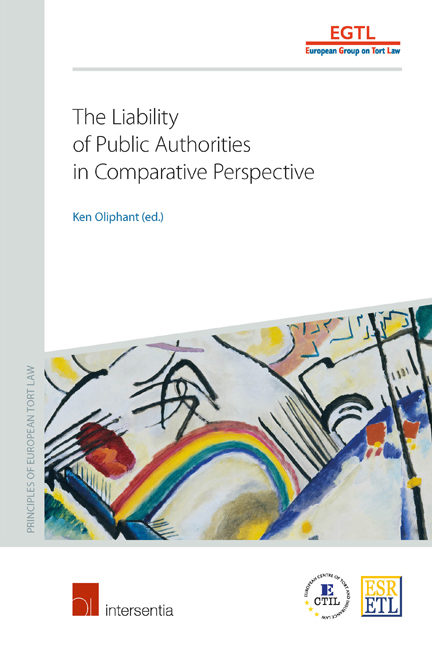Book contents
- Frontmatter
- Preface
- Contents
- List of Authors
- Introduction
- Questionnaire
- PART I PUBLIC AUTHORITY LIABILITY OUTLINED
- Austria
- Belgium
- Czech Republic
- Denmark
- England and Wales
- France
- Germany
- Greece
- Israel
- Italy
- The Netherlands
- Norway
- Poland
- Portugal
- South Africa
- Spain
- Switzerland
- The United States
- European Union
- The Liability of Public Authorities: an Economic Analysis
- PART II CASE STUDIES
- PART III CONCLUSIONS
Spain
from PART I - PUBLIC AUTHORITY LIABILITY OUTLINED
Published online by Cambridge University Press: 27 November 2017
- Frontmatter
- Preface
- Contents
- List of Authors
- Introduction
- Questionnaire
- PART I PUBLIC AUTHORITY LIABILITY OUTLINED
- Austria
- Belgium
- Czech Republic
- Denmark
- England and Wales
- France
- Germany
- Greece
- Israel
- Italy
- The Netherlands
- Norway
- Poland
- Portugal
- South Africa
- Spain
- Switzerland
- The United States
- European Union
- The Liability of Public Authorities: an Economic Analysis
- PART II CASE STUDIES
- PART III CONCLUSIONS
Summary
INTRODUCTION
OVERVIEW
The Spanish Constitution 1978 (CE) provides in art 106, sec 2, that
‘private individuals shall, under the terms laid down by law, be entitled to compensation for any harm they may suffer in any of their property and rights, except in cases of force majeure, whenever such harm is the result of the operation of public services’.
Accordingly, the Spanish Constitution has expressly laid down the principle of liability of public authorities, ruling out thereby any form of immunity for damage they cause to private individuals.
The principles enshrined in sec 2 of art 106 CE are the result of the developments experienced by Spanish public law concerning the liability of public bodies since the 1950s (see no 15 ff below). The current legal regulation of liability of public bodies is to be found in arts 139–146 of Act 30/1992, of 26 of November, concerning the Legal Regime of Public Administrations and General Administrative Procedure Act (LRJAP).1
According to sec 1 of art 139 LRJAP (Principles of liability),
‘Individuals will be entitled to be compensated by the corresponding Public Administrations for damage caused to their assets and rights, except in the case of force majeure, provided that the injury is a consequence of the normal or abnormal operation of public services’.
In order to be recoverable, damage must be effective, economically assessable and individualised in relation to a person or group of persons (art 139.2 LRJAP). The latter term refers to the idea of individual sacrifice, an idea that it has been necessary to underline, in particular in the case of claims brought by owners of properties or businesses affected by public works that have altered the layout of roads or tracks but which were not expropriated.
Illustration:
C owned a petrol station near a national road with high traffic density, with frequent congestion and a high rate of accidents. In order to improve mobility and reduce accidents, public authorities transformed the road into a highway. The highway, however, ran two kilometres away from C's petrol station and vehicle access to the highway was via a slip road located ten kilometres away.
- Type
- Chapter
- Information
- The Liability of Public Authorities in Comparative Perspective , pp. 463 - 506Publisher: IntersentiaPrint publication year: 2016

